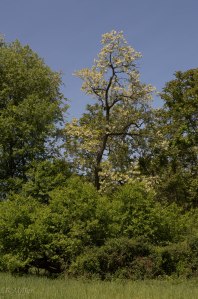Robinia pseudoacaia
Fabaceae
Originally a tree of the central Appalachians*, black locust has become naturalized through most of the US**. It isn’t grown commercially here, but is useful. The wood burns hot, and the flowers provide wonderful nectar for bees. Indeed, this is the “acacia” of Europe, from which we get acacia honey.
The tree also provides good wildlife cover, as well as cavities for nesting birds. There were several in the yard of my old house; when storm-damaged (they are susceptible), I left the snags standing so I could watch pileated woodpeckers feed on them.
Oddly, it’s considered “invasive, not banned” in Connecticut, and is prohibited in Massachusetts.
As you can see, it flowers profusely, with long, crowded racemes of fragrant blossoms.
Considering that it grows quickly up to 80 feet tall, suckers, and is prone to storm damage, it probably isn’t worth seeking out for your landscape. But if you have one already, enjoy it. And if you’ve never had acacia honey, make an effort to get some – it’s light golden, delicately flavored, and with a high fructose content, it’s slow to crystallize. It never lasts long enough in my house to crystallize, anyway.





I have a forest of these on my property. The oldest ones are at least 75 yrs old. I have made bowls out of the wood…..such wonderful grain patterns and yes …very solid hard wood i agree.
Lucky you! Especially if you heat with a wood stove.